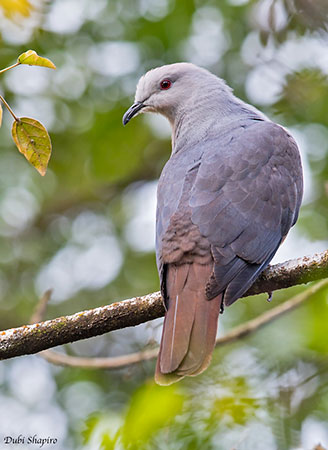
Male and female are similar, but the female has duller nape and breast.
The juvenile resembles adults, but it is duller. Most feathers show narrow, rufous-buff fringes.
RANGE:
The Barking Imperial Pigeon is found mainly on the larger islands. It is endemic to Fiji.
HABITAT:
The Barking Imperial Pigeon frequents mature moist forests, both in lowlands and mountains. It occurs from 60 to 1,000 metres of elevation, and can be seen in overgrown plantations near sea-level.
CALLS AND SONGS: SOUNDS BY XENO-CANTO
The Barking Imperial Pigeon gives a loud barking “u-oo” sometimes repeated in a long series, and another loud snarling or barking “raa” usually be heard once or twice. These barking calls give the bird its name. It also produces a series of repeated booming “wu-wu-wu-wu-wu-wu” or “oo-oo-oo-oo-oo-oo” and parrot-like squawks and soft cooing notes.
BEHAVIOUR IN THE WILD:
The Barking Imperial Pigeon is frugivorous. It usually feeds on large fruits from various plant species such as Cananga, Dysoxylum and Hyristica. It often forages alone or in pairs, but small groups of 3-4 individuals sometimes occur at fruiting trees.
It is arboreal and spends most of its time in the forest canopy where it perches on exposed branches. However, it may occasionally forage close to the ground.
It favours large fruits of 12-20 mm in diameter, and plucks them directly from the branches while hopping noisily through the canopy. It may hang upside-down to reach a fruit.
The breeding biology of this species is poorly known, but it is probably fairly similar to that of other Columbidae.
The Barking Imperial Pigeon is probably resident, with no movements recorded.
The flight is strong, fast and direct, with slow, regular wingbeats.
REPRODUCTION OF THIS SPECIES:
The breeding season takes place between May and January, with probably some local variations.
Like in other Columbidae, the nest is a flimsy platform made with twigs. It is usually built in the fork of a horizontal branch.
The female lays a single, white egg.
PROTECTION / THREATS / STATUS:
The Barking Imperial Pigeon is fairly common on the larger islands, especially on Vanua Levu, Taveuni and Rabi.
It is threatened by heavy hunting and habitat destruction, especially on Viti Levu.
The population is suspected to be declining, but the Barking Imperial Pigeon is not globally threatened and currently evaluated as Least Concern.
Fr: Carpophage de Peale
Ang: Barking Imperial Pigeon, Peale's Imperial-Pigeon
All: Braunschwanz-Fruchttaube
Esp: Dúcula Ladradora
Ita: Piccione imperiale di Peale
Nd: Peales Muskaatduif
Sd: fijikejsarduva
Photographer:
Dubi Shapiro
Dubi Shapiro Photo Galleries & Dubi Shapiro's Pictures on IBC
Text by Nicole Bouglouan
Sources:
HANDBOOK OF THE BIRDS OF THE WORLD vol 4 by Josep del Hoyo-Andrew Elliott-Jordi Sargatal - Lynx Edicions - ISBN: 8487334229
PIGEONS AND DOVES by David Gibbs, Eustace Barnes and John Cox - Pica Press Sussex - ISBN: 1873403607
Fiji Bird Watching - Peale’s Imperial ‘Barking’ Pigeon
Wikipedia, the free encyclopaedia
Barking Imperial Pigeon or Peale's Imperial-Pigeon
Ducula latrans
Columbiformes Order – Columbidae Family
INTRODUCTION:
The Barking Imperial Pigeon is endemic to Fiji where it frequents mature, closed-canopy, moist forest, both in lowlands and mountains. It feeds on large fruits from various plant species.
The Barking Imperial Pigeon is fairly common within its restricted range, but the population is declining, due to hunting pressure and habitat destruction.
DESCRIPTION OF THE BIRD:
Biometrics:
Length: 40-44 cm
The Barking Imperial Pigeon has ashy-grey upperparts with mostly dark brown back, upperwings and uppertail.
On the underparts, chin and throat are pale vinaceous-grey, shading into the ashy-grey ear-coverts and neck. The breast is darker than the neck. It is tinged with dark pinkish and shades into the buff belly. The sandy-buff thighs are washed grey. The undertail-coverts are pale yellowish-buff with dark grey streaking. The underwing is dark brown with dark chestnut coverts.
On the head, forehead, lores and crown are dark ashy-grey, with vinous-brown wash on central crown and nape.
The bill is blackish. The eyes are red to purplish-red, and surrounded by red eyering. Legs and feet are red to brownish-red.
